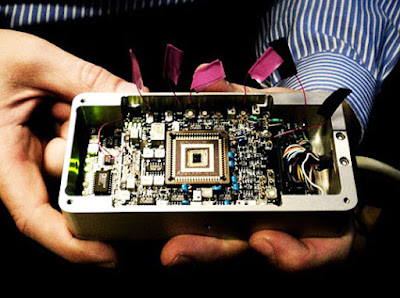| Clipped from: Personal Robots Group - MIT Media Lab |
| Clipped from: MIT Media Lab - Wikipedia, the free encyclopedia |
MIT Media Lab
The MIT Media Lab (also known as the Media Lab) is a department within the MIT School of Architecture and Planning. Devoted to research projects at the convergence of multimedia and technology, the Media Lab was widely popularized in the 1990s by business and technology publications such as Wired and Red Herring for a series of practical inventions in the fields of wireless networks, field sensing, web browsers and the World Wide Web. More recently it has focused on product design more generally, particularly for technologies that address social causes.[1]| Clipped from: Projects |
| Clipped from: Overview |
Leonardo
This project is a collaboration with the world famous Stan Winston Studio. It combines the studio's artistry and expertise in creating compelling animatronic characters with state of the art research in socially intelligent robots. We have christened this new character collaboration with a name that embodies art, science and invention. Hence, the name "Leonardo" -- namesake of Leonardo DaVinci, the Renaissance scientist, inventor and artist.| Clipped from: Overview |
MDS
The purpose of this platform is to support research and education goals in human-robot interaction, teaming, and social learning.| Clipped from: YouTube - Nexi (M.I.T. MediaLab) at Laval Virtual 2009 |
| Clipped from: Overview |
Huggable™
The Huggable™ is a new type of robotic companion being developed at the MIT Media Lab for healthcare, education, and social communication applications. The Huggable™ designed to be much more than a fun interactive robotic companion. It is designed to function as a team member that is an essential member of a triadic interaction. Therefore, the Huggable™ is not designed to replace any particular person in a social network, but rather to enhance that human social network.| Clipped from: Overview |
Aida
The aim of the Personal Robot's portion of the project is to expand the relationship between the car and the driver with the goal of making the driving experience more effective, safer, and more enjoyable.| Clipped from: YouTube - AIDA in Dash |
| Clipped from: Overview |
Tofu
TOFU is a project to explore new ways of robotic social expression by leveraging techniques that have been used in 2d animation for decades.| Clipped from: YouTube - Meet TOFU |
Sources:
Personal Robots Group - MIT Media Lab
MIT Media Lab - Wikipedia, the free encyclopedia
Projects
Leonardo
YouTube - Leonardo Robot - isn't this the cutest robot ever?
MDS
YouTube - Nexi (M.I.T. MediaLab) at Laval Virtual 2009
Huggable
YouTube - Siggraph 2006 - MRI (Mixed-Reality Interface)
Aida
YouTube - AIDA in Dash
Tofu
YouTube - Meet TOFU
Related:
MIT Media Lab
Personal Robots | MIT Media Lab
Personal Robots | MIT World
QTC Robot Skin Feels How Hard You Touch – Coming soon to MIT, Samsung, Others | Singularity Hub
Meet Nexi, the Media Lab's latest robot and Internet star
MIT's 'Tofu' Robot Mixes Science, Ridiculous Cuteness | Technomix | Fast Company




































